What Do I Need to Color My Hair at Home
As much as I love getting my hair colored professionally, there's always a tiiiiiny little voice in my head telling me I should cancel my appointment, buy some box dye, and dye my hair at home. Like, yes, I'm fully aware that my colorist has years of training and experience and knows how to mix and customize my hair dye like a g'damn wizard, but when I'm feeling (A) impatient or (B) broke as f*ck, I like to take things into my own hands. And since I don't think I'll be sitting in a salon chair any time soon, my box-dyeing skills have never felt more useful (@ my mom, who spent years telling me to "just leave your hair alone").
I can confidently say I know my way around a bottle of hair dye by now, but I've made literally every mistake imaginable along the way—see: the time I got permanent color all over my ears, or when I bought the wrong box and was left with a red hue I definitely didn't sign up for. And since I'd hate to have your first experience with box dye be a total shit show, I broke down every tip, trick, and product rec you'll need to make the process a whole hell of a lot easier. I even chatted with Meri Kate O'Connor, colorist at Tabb & Sparks Salon in Santa Monica, CA, for a few expert-approved hacks, too. Basically, you're in good hands.
This content is imported from {embed-name}. You may be able to find the same content in another format, or you may be able to find more information, at their web site.
How to Dye Your Hair at Home
Step 1: Find the right hair-dye color
Obviously, the first step in your at-home coloring journey is buying the dye. But instead of hitting up Amazon and ordering the prettiest-looking box, lemme just emphasize the importance of finding the right shade. "When you get your hair done at a salon, your colorist combines various dyes and developers—chemicals that activate the dyes—to get you to your dream shade," says O'Connor. "With box dye, you're working with one dye and one developer—it's a one-size-fits-all situation."
So set some realistic expectations—and while you're at it, ignore those misleading swatches on the back of the box. Instead, think of box dye as the perfect way to ~tweak~ your hair color, whether that means upping shine or adding some dimension. And commit to this rule: Limit your at-home dyeing to two shades darker or half a shade lighter than your natural color. "If you're going darker, you have a good shot at getting the color you see on the box, since you aren't taking anything away from your base color," says O'Connor. "But if you're trying to go a lot lighter, your room for error skyrockets."
Also important: Shades labeled "warm" or "golden" often end up looking orange (turns out, amateurs can't really control "warmth"), so always opt for "cool" or "neutral" just to be safe, especially if your shade skews red at all.

John Frieda Precision Foam Colour

Shea Moisture Nourishing Moisture-Rich Hair Color Crème Kit

Madison Reed Radiant Hair Color Kit
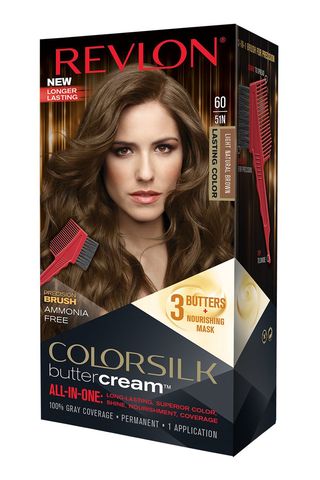
Revlon Colorsilk Buttercream Hair Dye
Step 2: Decide on permanent or semi-permanent dye
Alright, here's where things get a little technical. There are three main types of hair dye: semi-permanent, demi-permanent, and permanent—all of which (obviously) have different lifespans. Here's how to figure out which hair dye is best for you:

Imaxtree
⇝Semi-permanent hair dye:
These dyes last 15 washes, max. "There's no developer, there's no hydrogen peroxide, there are no chemicals—the color just sits on the hair's surface," says Patricia Slattery, AVP of hair color education, training, and testing at L'Oréal Paris. P.S. If a box's fine-print instructions tell you to mix anything at all, the dye is not actually semi-perm and will last closer to 28 washes. Confusing, yes (and why I'm here for ya!).
⇝Demi-permanent hair dye:
Demi dyes will blend a new color with your natural color—but it won't do anything major, like cover grays. "Demi-permanent is great for people who want to amp up their existing color—like making chestnut-brown hair richer and shinier—for three to four weeks without having noticeable roots during a grow-out phase," says Slattery.
⇝Permanent hair dye:
"These dyes are spiked with ammonia, which, when combined with hydrogen peroxide, penetrate deep into the cortex of your hair," says Slattery. The result: long-lasting color that fades sliiightly over time (kinda like a black T-shirt every time you wash it) and needs to be touched up every four to six weeks as your roots grow in.
⇝Hair-dye alternatives:
Okay, I lied: There's technically a fourth category of hair dye, but it's definitely not conventional. Some of the most common DIY hair-dye alternatives are Kool-Aid (#tbt), henna, chamomile, lemon, and apple cider vinegar (which, yup, can lighten your hair naturally). Just keep in mind that most natural alternatives are best used on virgin hair, since there's no way of knowing how something like lemon will interact with any hair dye or bleach that might already be on your strands (and you probs don't want to find out...).
This content is imported from YouTube. You may be able to find the same content in another format, or you may be able to find more information, at their web site.
Step 3: Prep your hair before dyeing it
If you're taking the time to color your hair at home, it's worth it to put in a little prep work to make sure the process goes smoothly. The easiest way to keep your scalp safe while you're coloring it? Work with three-day-old hair. "I suggest not washing your hair for a few days before coloring it, since your natural oils will help protect your scalp from any chemicals in the dye," says O'Connor.
One more thing: Before you mix up your dye, grab a tub of Vaseline. "You can smooth some Vaseline around your hairline and on your ears to protect your skin from staining," says O'Connor, since there's legit nothing worse than washing out your color and realizing you've dyed your skin (which, guilty).
Step 4: Follow the box dye instructions
Keep in mind that every box dye comes with its own set of instructions, so make sure you read 'em carefully before you get started. After you mix up your dye (your instructions will walk you through it, though you'll usually just shake up a bottle of color and developer), throw on a pair of gloves, and start with your roots. "Your roots need the most time to develop, so if you're coloring your whole head, you'll want to start at the top and pull the dye down through your ends," says O'Connor.
Feeling a little lost? Check out this easy-to-follow tutorial for a few pointers:
This content is imported from YouTube. You may be able to find the same content in another format, or you may be able to find more information, at their web site.
How to color gray hair at home
Got a few gray hairs peeking through, but not quite ready for a full-on dye job? You can totally color your gray hairs at home, and there's a shit-ton of methods out there, including root touch-up kits (targeted hair dye that you comb through your roots) and concealer sprays (dry shampoo-like formulas that temporarily tint your hair until you wash them out). These are some of my personal faves, all of which are incredibly easy to use:
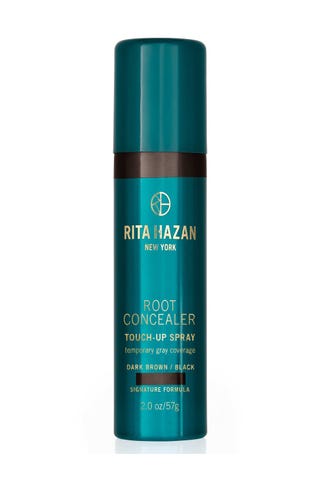
Rita Hazan Root Concealer Touch-Up Spray


L'oreal Paris Magic Root Cover Up
lorealparisusa.com
$20.00

How to fix hair dye mistakes
⇝If you dyed your hair too light...
If you rinse out your hair dye and it's not the rich, chocolate-brown hue you thought it'd be, don't freak—you've definitely got options. You'll just have to wait a couple weeks until you can dye your hair again, since even the healthiest of strands can't withstand multiple rounds of dye in one sitting. That said, once you've given it a little time (and, like, invested in a good hat), you can reapply the same color and let it sit for less time, checking it every five to seven minutes before rinsing to make sure it doesn't go too dark, says O'Connor.
⇝If you dyed your hair too dark...
"If you've gone too dark, I'd first suggest using a clarifying shampoo to help lift some of the pigment," says O'Connor. Basically, the harsher the better, so look for one with sodium lauryl sulfate in the ingredients list—which, usually, would be your nightmare, but for stripping color? Go for it (once). "You should follow with a deep conditioner, though, since clarifying shampoos tend to be a little harsh." When in doubt, O'Connor always suggest going to a professional to fix any major mistakes (even if that means hopping on FaceTime).
How to make your hair color last longer
Alright, so you've got the perfect hair color—now it's time to make sure it stays perfect. Semi-permanent hair color can last up to 12 washes, but only if you're taking care of it. That means using a sulfate-free shampoo and conditioner every time you wash your hair, as well as an ultra-hydrating mask or treatment that'll work to repair any dryness or damage (Olaplex Hair Perfector No. 3 is an industry favorite, as is Christophe Robin Shade Variation Care Nutritive Mask with Temporary Coloring).
Pick up my go-tos, below, and then enjoy that new color of yours.
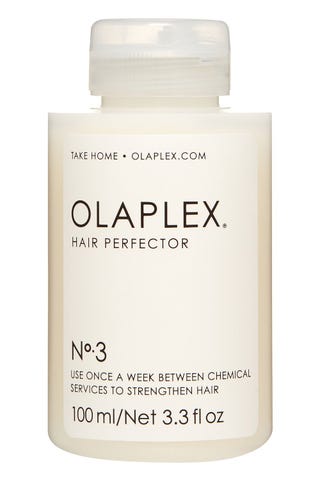
Olaplex Hair Perfector No. 3
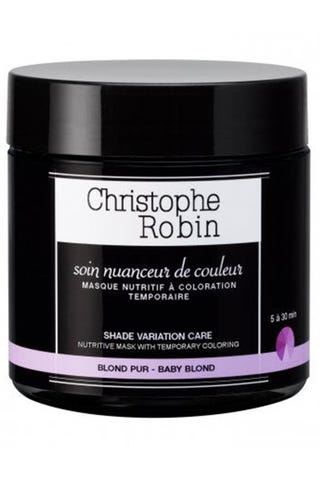
Christophe Robin Shade Variation Care Nutritive Mask

Amika Vault Color-Lock Shampoo
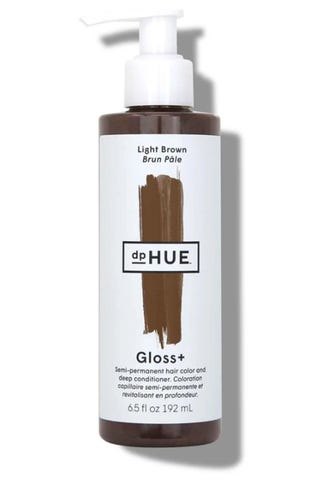
dpHUE Gloss+ Semi-Permanent Hair Color and Deep Conditioner
Ruby Buddemeyer Ruby was the beauty editor at Cosmopolitan, where she covered beauty across print and digital.
This content is created and maintained by a third party, and imported onto this page to help users provide their email addresses. You may be able to find more information about this and similar content at piano.io
What Do I Need to Color My Hair at Home
Source: https://www.cosmopolitan.com/style-beauty/beauty/advice/a44632/hair-color-things-you-must-know/